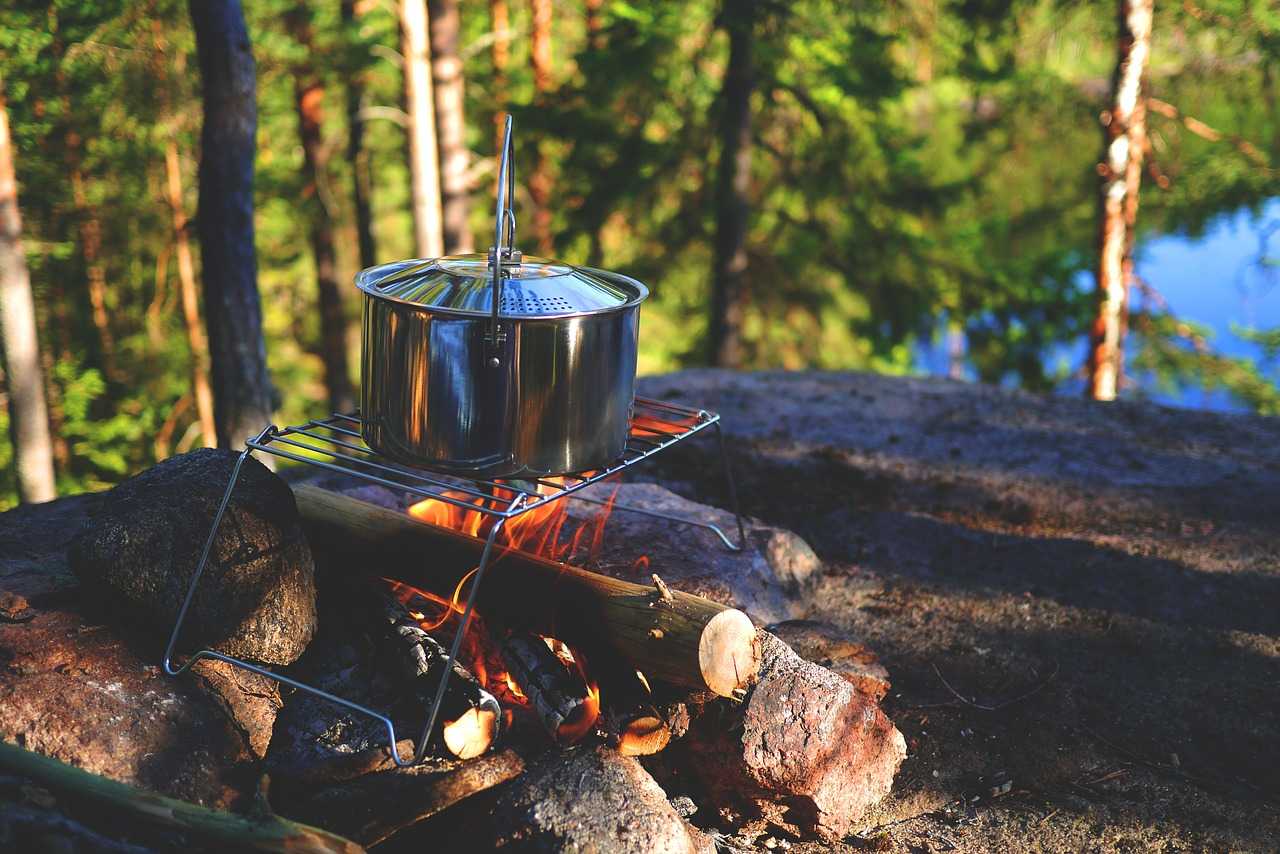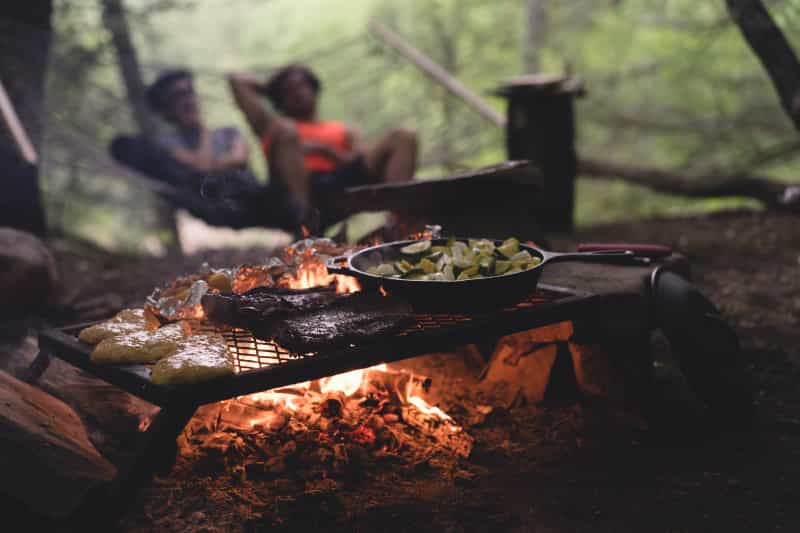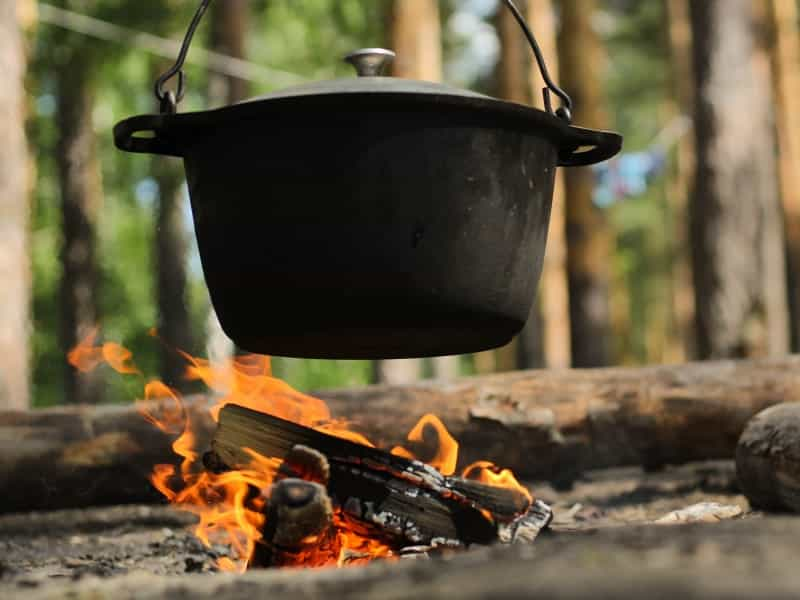Cooking on a campfire: a beginners’ guide
Nothing says ‘camping’ quite like a campfire.
The social highlight of many camping trips, a campfire is great for warming weary limbs after a day of hiking – and an equally great place for making (and eating) dinner. After all, if you’re building a campfire for warmth, you might as well double down and put it to good use for cooking, too.
Before even starting to think about cooking a meal on a campfire, though, make sure that you’ve picked a campsite that allows campfires.
See all Pitchup campsites that allow campfires
If you’ve never prepared food on a campfire before, you might think it’s all about sausages or reheated beans, but that's far from the case.
Read our beginners’ guide for cooking on a campfire – from building a fire to essential campfire cooking equipment for tasty, easy-to-make recipes.

How to cook on a campfire
1. Build a campfire for cooking
Those who are just beginning to dip their toes in the world of campfire cooking might want to start simple, by purchasing a suitable container such as a firepit. Opt for something with legs (so it sits safely off the ground) and, ideally, a few accessories – most important is a grill grate, though if you’re camping with children or dogs a protective cover might also be a good idea.
It’s important to source all the materials you need in advance of building your campfire (to prevent the frustration of having to leave it half-built while you go looking for a missing element, if nothing else).
For a successful campfire, you will need:
-
Large stones or rocks
You need enough of these to build a circle; the size of this will usually be dictated by the size of your grill grate.
-
Tinder
This should be something that burns quickly: dry leaves or pine needles, or small bits of dry wood; in a pinch, you can use scrunched-up newspaper, too. -
Kindling
This consists of larger twigs or small branches. -
Fuel wood
The site where you’re staying or a nearby farmer’s shop might sell bags of firewood; alternatively, some sites allow you to collect fallen branches in the woods.
What you're looking for is dry, seasoned, thin logs (about as thick as your wrist), which burn well and are relatively kind to the environment. It's best to avoid softwoods like pine and spruce, since their high resin content might affect the taste of your food.
-
Matches
-
Water or sand
It’s a good idea to have a bucket of water or sand as a safety precaution
Next, find a suitable location to build your campfire from scratch. You’re looking for a spot that is:
-
on flat ground
-
on bare earth (not grass) and clear of any debris
-
at least three metres away from tents, bushes and anything else that could go up in flames
-
well away from overhanging tree branches and with no power lines overhead
-
sheltered from the wind (though with anything stronger than a gentle breeze, you would be advised not to start a fire at all).
Start by building a circle of large stones or rocks – this is the outer edge of your campfire. If you’re using a grill grate, the stone ring should be roughly the same size.
Place small bits of tinder at the centre of the ring, then build a tipi of larger twigs on top, followed by a tipi of fuel wood. Set up your tripod (if using one) slightly off the centre of the fire base so that the heat won’t be too fierce, then carefully set alight the tinder at the heart of your tipi with a long match. (Steer clear of chemical-based fire igniters if your intention is to cook food.)
If you’ve built your campfire correctly, the flames should then spread to the larger logs.
For more details (including how to extinguish your campfire and dispose of residual ashes), follow our step-by-step guide to building a campfire.

2. Be patient
Flames are great – they mean you’ve built your fire successfully; however, it doesn’t follow that you can now proceed straight to cooking. You need to wait at least half an hour for your logs to burn down to a bed of hot coals, which will provide a more consistent and evenly distributed heat (which is what you need for cooking) than a roaring fire.
3. Keep your fire small
Bigger isn’t necessarily better when it comes to campfires. The secret to successful campfire cooking is heat control, which is easier to achieve when the fire is small and manageable. Another advantage to adding extra wood gradually, and only when needed, is that your stash of logs will last longer, so you can linger by the fire after dinner.
4. Avoid direct heat
Cooking on open flames is likely to result in food that’s burned on the outside and raw on the inside. Avoid this by raking some coals to the very edge of your stone ring and setting up your grill or tripod above them, away from the fiercest, hottest fire.
5. Safety first
Always keep at a safe distance from the fire, and wear the appropriate protective gear (such as heatproof gloves) when approaching to stir a pot or retrieve a parcel from the embers. Don’t forget that spits of fat, oil or sugar can cause flare-ups, and keep some water to hand to sprinkle on stray embers.
6. Bring the right cooking equipment
In order to produce successful campfire meals (and feel like a pro while doing it), you need the right tools for the job. Investing in the appropriate cooking equipment will make a world of difference to your culinary efforts.
Cast-iron cookware works really well on a campfire, but any large metal cooking pot will do, so long as it doesn’t have plastic handles. Besides that, the equipment will depend largely on what you’re planning to cook.
Campfire grill grates
These are great for things that need direct heat (such as kebabs), or as a support for a cooking pot or a Dutch oven. You can buy a flat grill grate to balance on stones over the fire (or, more appropriately, the hot coals) or one with foldable legs to raise the cooking surface.
Cast-iron pans
Choose a pan with a lid so you can use it for stews, as well as for open cooking of things like toasties, eggs and potato hash.
Dutch ovens
Ideal for soups and stews (but also suitable for baking bread and making popcorn), a Dutch oven is a large cooking pot with a lid and (usually) hooks for hanging. If you’re going to buy one, go the distance and buy a tripod from which to hang it.
Skewers
Long skewers are good for kebabs and marshmallows. Metal is best, but you can also use wooden skewers – soak them in water first, though, or they might catch fire.
Tinfoil
Potatoes, corn and parcels of meat, fish or veg can all be wrapped in foil (always use a double layer) and cooked in the embers.
Assorted utensils
Plastic is out, and metal is in when it comes to utensils. No need to bring the whole kitchen drawer, but you’ll need at least one long spoon to stir, tongs for turning and removing items from the fire, and a ladle for serving soups and stews. And since you don’t want to be handling pots and metal utensils with bare hands, make sure you pack a good pair of heat-resistant gloves, too.

7. Be prepared
As with everything in life and camping, preparation is key. You can cut down on the work to do on site by having the ingredients for your recipes already measured out in well-labelled Tupperware containers or food bags – whether it’s grated cheese for your jacket potatoes or pre-chopped vegetables for your skewers. You can also pre-make entire meals – from stews to curries; all you need to do on site is add a little stock and reheat.
Bonus points if you can freeze some (or all) of these pre-prepared elements, since they will act as natural ice packs in an insulated cooler bag.
5 simple meals to cook on a campfire
From breakfast to dinner (plus a dessert to boot…), here are five simple campfire recipes for hungry holidaymakers.
1. Breakfast potato hash
This dish is at its easiest if you bring along some potatoes you’ve already chopped and boiled at home. Cook them in a pan with a little oil and other ingredients of your choice: maybe a little spicy chorizo, chopped tomatoes (or tomato sauce), chopped onion, garlic or herbs. Crack an egg on top of the hash and let it cook for a couple of minutes.
2. Chilli con carne
Heat a little olive oil in a cast-iron pot, then add the mince with some onion, garlic and chilli powder. Add some kidney beans and canned tomatoes, and place the pot in an area of medium heat so it can cook slowly. Serve it with a potato baked in tin foil in the embers.
For a vegetarian chilli, use chopped peppers as an alternative to the beef.
3. Fish parcels
Double wrap a fillet of fish (salmon or cod work especially well) in foil, along with some herbs and lemon juice, maybe some thinly sliced potatoes or black olives, and cook in the embers for about 10 minutes.
4. Veggie kebabs
There’s no limit to what you can use for your skewers: peppers, courgettes, aubergines, onions, halloumi cheese… Make your prep easier by chopping everything at home.
5. Chocolate banana
Split a banana lengthways, fill the centre with chocolate buttons and then wrap it all in two layers of foil. Pop the parcel in the embers for a few minutes until the chocolate melts.
What not to cook on a campfire
Just as there are foods that are ideal for campfire cooking (kebabs, for example), so there are others that you should approach with caution – or not at all. This category includes:
-
Anything deep fried – the last thing you want on your open fire is a pan full of boiling oil.
-
Bacon, steaks or anything that might drip (and spit) hot fat into the flames. (If you can’t live without your breakfast rashers, cook them in a Dutch oven instead.)
-
Anything that requires a splash of spirits. Rum-flambéd pineapple rings may sound delicious, but you don’t want to risk pouring alcohol on the fire.
In addition to cooking safety, you should consider standard issues of food safety – for example, chicken and pork need to be cooked through to avoid food poisoning.
Campfire cookery FAQs
Do all campsites allow campfire cooking?
Not all sites allow campfires. This is usually due to safety reasons; indeed, even sites that do allow campfires might enforce a temporary ban during long periods of prolonged dry weather.
If you’re keen to use your Dutch oven or grill grate on your next camping trip, make sure you’re booking a site that allows campfires.
What equipment do I need to cook on a campfire?
Campfire equipment depends on both budget and how keen a cook you are. If you’re taking your first steps in the world of campfire cooking (and are unsure whether to invest), start with metal skewers or tinfoil.
After that, you can progress to grill grates (which are affordable, portable and ideal for cooking favourites like kebabs) and cast-iron cookware.
Is campfire cooking safe?
A few simple precautions – from protective gear to using the right tools – go a long way towards ensuring safety around the campfire. Keep the fire small and manageable, and have a bucket of water or sand nearby in case you need to extinguish any stray embers.